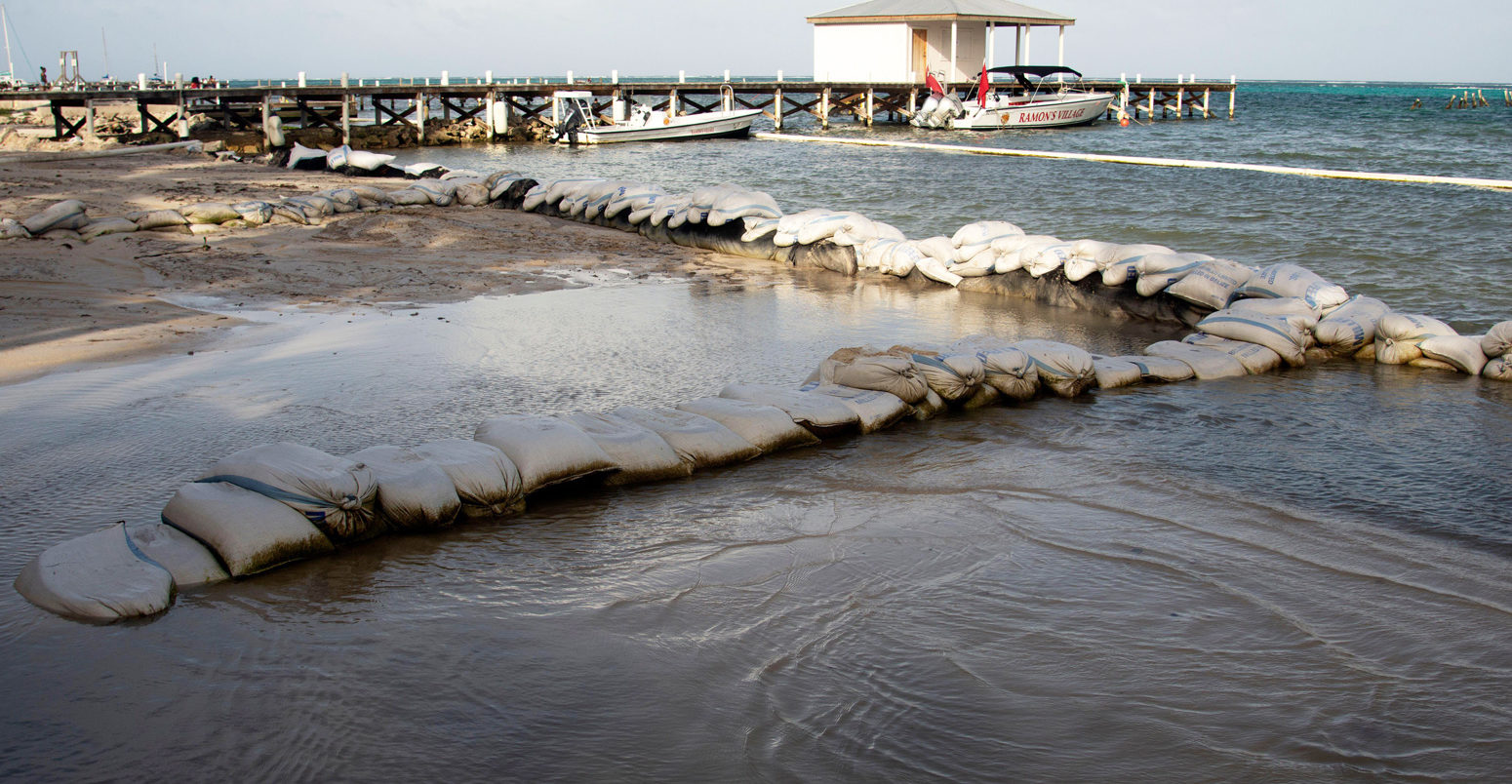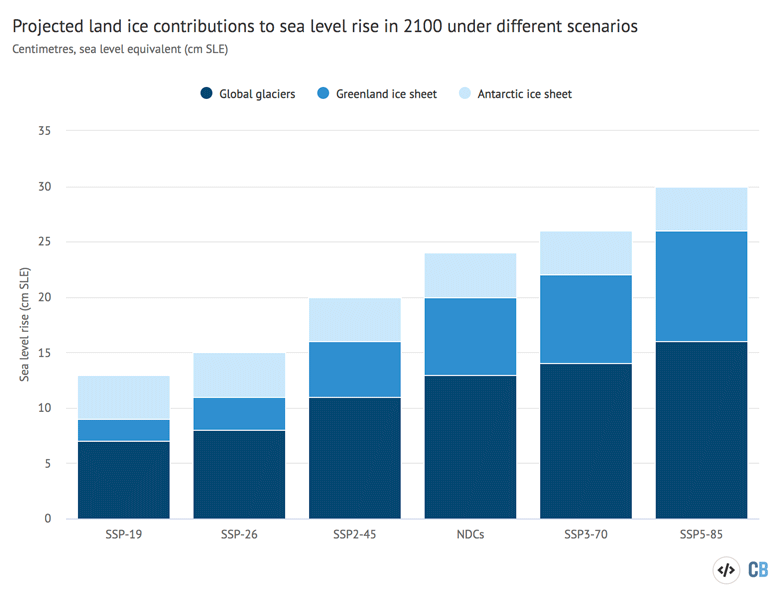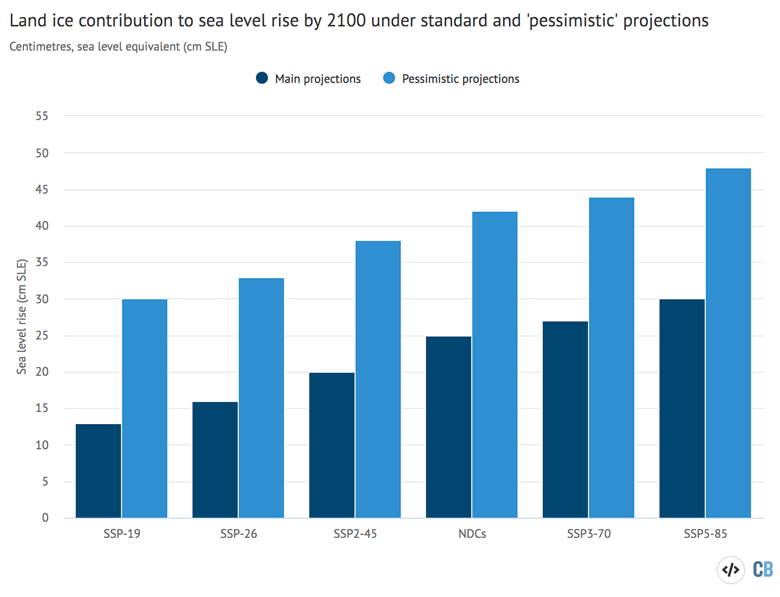
Limiting warming to 1.5C would ‘halve’ land-ice contribution to sea level rise by 2100
Ayesha Tandon
05.05.21Ayesha Tandon
05.05.2021 | 4:02pmHolding global temperature rise to no more than 1.5C – rather than following current emissions pledges – could halve the sea level rise from melting land ice by the year 2100, according to new research.
The Nature study, which brings together 84 authors from 62 institutions, projects future sea level rise using the latest models and future pathways. It estimates that, if current pledges to reduce emissions are met, land-ice loss will drive around 25cm of sea level rise by 2100. However, this falls to 13cm if warming is limited to 1.5C above pre-industrial levels.
The authors note that mountain glaciers and the ice sheets of Greenland and Antarctica will respond to the lower warming levels in different ways. Greenland ice sheet mass losses would reduce by 70%, while the contribution from Antarctica is relatively consistent across all warming levels due to the “competing processes” of melting ice and increased snowfall.
The authors also investigate a “pessimistic, but plausible” scenario of melt from Antarctica, finding that – if the most extreme ice sheet behaviour is assumed – Antarctic ice loss could be five times higher. This would push the land-ice driven sea level rise in 2100 from 25cm to 42cm under current emissions pledges.
However, a second study – also published in Nature – warns that ice loss from Antarctica could be greater still. The authors suggest that a process called “marine ice-cliff instability” could come into play if global warming is not limited to 2C, potentially driving an “abrupt jump” in the rate of Antarctic ice loss.
Land-ice melt
The new study focuses on “land ice”, which includes mountain glaciers and the colossal ice sheets covering Greenland and Antarctica. According to the 2019 special report on the ocean and cryosphere in a changing climate by the Intergovernmental Panel on Climate Change (IPCC), melting land ice has driven half of sea level rise since 1993.
The authors investigate potential land ice melt under six future scenarios of warming and socioeconomic development. The scenarios range from the low-emissions, high-equality SSP1-19 scenario – consistent with keeping warming below 1.5C in 2100 – to the high-emissions, low-equality SSP5-85 scenario. The authors also include an “NDC scenario” in which all countries meet their “Nationally Determined Contributions” – pledges to reduce emissions under the Paris Agreement.
The authors built a statistical model, called an “emulator”, to bring together the models from the Ice Sheet Model Intercomparison Project (ISMIP6) and the Glacier Model Intercomparison Project (GlacierMIP) for the sixth Coupled Model Intercomparison Project (CMIP6). Between them, the groups contributing to these global modelling projects have provided 256 simulations of the Greenland ice sheet, 344 simulations of the Antarctic ice sheet and 288 simulations of the global glacier response to climate change.
The plot below shows the projected sea level rise from the different land ice components by the year 2100. The lowest future warming scenario is on the left and highest warming scenario is on the right. The contribution from glaciers is shown in dark blue, the Greenland ice sheet in mid blue and the Antarctic ice sheet in light blue.

Prof Jonathan Bamber, a glaciologist from the University of Bristol, tells Carbon Brief that glaciers and ice sheets generally respond differently to warming because of their different masses:
“Because the ice sheets are orders of magnitude bigger than glaciers they respond on different timescales and in different ways. For example, in Antarctica there is very little ice loss due to surface melting and almost all ice is lost directly into the ocean, while for most glaciers, ice is lost almost entirely from the surface.”
The plot shows that moving from current emission pledges (NDC) to a 1.5C warming scenario (SSP1-19) is expected to reduce mass loss from the Greenland ice sheet by 70% and halve mass loss from glaciers.
However, the Antarctic ice sheet’s response to warming is more “complex”, according to the study. Warmer temperatures allow the atmosphere to hold more moisture, leading to increased snowfall and allowing the ice sheet to gain mass.
For East Antarctica, its sheer size – it holds enough ice to raise sea levels by 53.3 metres, compared to 4.3 metres for West Antarctica – means that gains in snowfall outweigh the increase in mass loss from melting at its edges.
A warmer planet therefore means that the East Antarctic ice sheet will contribute less to sea level rise in the scenarios modelled, the authors explain.
However, West Antarctica shows a mixed response to warming, the study says. Some West Antarctica simulations predict that faster warming leads to faster melting, while others suggest that West Antarctica will show the same response to warming as East Antarctica.
Due to these “competing processes” of melting and snowfall, the study concludes that the Antarctic contribution to sea level rise is fairly consistent across the different scenarios – at around 4cm by 2100. However, Dr Tamsin Edwards – a climate scientist at Kings College London and lead author on the study – emphasised in a press briefing in London on Tuesday that this does not mean Antarctica is not responding to climate change:
“We’re not saying that we don’t think Antarctica will respond to climate change. What we’re saying is that when you look at lots of different climate models and ice sheet models, the amount that Antarctica responds to climate change varies very widely. And so because we’re doing the synthesis across so many models, what you end up with is an averaging out across many different models.”
‘Pessimistic, but plausible’ Antarctic melt
As well as the standard projections shown above, the authors also produce a set of “pessimistic, but physically plausible” projections for Antarctica. In the pessimistic scenario, the authors combine a range of assumptions that drive high sea level rise from the Antarctic ice sheet.
For example, the pessimistic projections include “ice shelf collapse”. This process takes place when pools of water form on the surface of ice shelves – floating sheets of ice that are permanently attached to the land mass. If the pools grow big enough, they can cause the shelves to “collapse”, allowing large sections of ice break away from the main sheet of ice.
The authors project that sea level rise from the Antarctic ice sheet is five times higher in these “pessimistic” projections than in the standard ones, rising from 4cm to 21cm sea level rise contribution by 2100 under all scenarios.
The chart below shows expected sea level rise from land ice by 2100, under six different future warming scenarios. Projections using that “standard” Antarctic melt scenario are shown in dark blue, and those using the “pessimistic” scenario are shown in mid blue.

Edwards told the press conference that the pessimistic projections could be useful for stakeholders with assets on the coast that they want to protect:
“We’ve been having lots of meetings with decisionmakers and stakeholders. Some want our best estimate using all of the data – the full range – and that’s our main baseline projection. But if you own a nuclear power plant on the coast, or if you’re defending London or New York, then you might have the concern and the budget to protect against the higher level of risk.”
Antarctic uncertainty
The authors also note that the response of the Antarctic ice sheet to warming is “complex, only partially understood, and involve[s] compensating factors of increasing mass loss and gain that result in a balance we are not yet confident about”.
As such, there is a high level of “uncertainty” in the Antarctic response to warming – meaning that when multiple models are run, there is a large spread of results.
There are also physical processes that could take place in the Antarctic ice sheet that are not included in the model. One of these is “marine ice cliff instability” (MICI). This describes a process in which towering ice cliffs at the face of glaciers could collapse into the ocean under their own weight, triggering further collapse.
Bamber tells Carbon Brief that, because MICI is not included, the study “only captures part of the complete uncertainty in projecting sea level rise due to melting land ice: the ‘known uncertainties’”.
Prof Sophie Nowicki from the University of Buffalo, a co-author on the paper, told the press conference that it is difficult to model the MICI process, adding “we need more observations to really be able to put it correctly”.
Prof Robert DeConto, a professor in the department of geosciences at the University of Massachusetts, Amherst was not involved in this study, but is the lead author on a second study – published at the same time in Nature – which focuses on Antarctica’s potential contribution to sea level rise. (DeConto and his co-authors have written a Carbon Brief guest post about their research.)
He tells Carbon Brief that MICI could occur when ice shelves thin and break up, taking away the “buttressing” effect they have of holding back the glaciers that flow into them. This would leave the huge glacier ice cliffs exposed, causing them to “crumble away because there’s no structural support”. He adds “these processes are actually observed – they’re really undeniable”.
DeConto says that his team incorporates the MICI process into their Antarctic ice sheet model. As such, the results of his study start to diverge from those of the Edwards et al study at warmer temperatures, he explains:
“What’s fundamentally different is that the models that were used in the Edwards study don’t include some glaciological processes that we think could become really critically important in the future. And that’s ultimately the reason why once we get to about 3C+, our results start to diverge from her study. At really low emissions, it’s a similar picture – within a few centimetres really – it’s just it’s once you get into a warmer world we really start to diverge because these processes kick in.”
However, Edwards told the press conference that, while DeConto’s numbers are higher, they are still consistent with the projections in her study:
“Some of the ice sheet models are similarly sensitive, I would say, to the DeConto model in the other paper that go into that risk averse [pessimistic] projection – but for different reasons. They have lots of melting if you warm the ocean, or faster flowing ice in the future. And so, actually, although his numbers are perhaps a bit more towards the upper half of our predictions, particularly the high warming scenarios, it’s certainly consistent, and there are other models that are getting fairly similar numbers but for different reasons, so you know it’s an active area of research, definitely.”
Interestingly, the authors find that “switching on” ice shelf collapse in their models only increased the Antarctic contribution to sea level rise by around 1cm, “because surface meltwater is not projected to be enough to cause collapses until the second half of the century, and even then only for a small number of shelves.”
However, Dr Ella Gilbert from the University of Reading – who was not involved in the study, but recently penned a Carbon Brief guest post on her research into Antarctica’s ice shelves – tells Carbon Brief that, due to the melt threshold used and the low resolution of the climate models, she expects that “the likelihood of collapse could actually be higher”.
Furthermore, Dr Jeff Ridley from the UK Met Office tells Carbon Brief that the research only looks to the year 2100, but that “ice sheets do not change much on such a timescale”. He adds that if “extended scenarios” could have been run out to the year 2300, “all the feedbacks” would have started to kick in.
Scientists responses
The study has received a mixed response from the scientific community.
Dr John Church, a co-convening leader on the IPCC’s fifth assessment report (AR5), tells Carbon Brief that the paper is “important”, and “brings together a very large volume of work and puts it into a very policy relevant framework”. He adds that the results “confirmed much of what was argued in the AR5”.
Dr Andra Garner, an assistant professor at Rowan University who was not involved in the study, adds that the work is “very intriguing, and is likely to have a significant impact on the field”.
She also notes that land ice melt is the biggest uncertainty in future sea level rise:
“The largest part of our uncertainty in future sea level rise projections is related to land-ice contributions. So, this innovative work to estimate the uncertainty of future land-ice contributions to sea level rise by emulating a range of different models is an important step towards better understanding that largest, most uncertain piece of the sea level rise puzzle”.
Prof Martin Siegert – co-director of the Grantham Institute at Imperial College London, who was not involved in the study – tells Carbon Brief that developing 21st sea level rise projections is “one of the big challenges of our time” and that this study “is probably the best attempt that we have at that exercise”.
However, he says that the progress made in this paper is “incremental”:
“There is an awareness that the IPCC is under-predicting the worst case scenario. And what this paper does is sort of say that ‘we’re still doing that and we’re aware that we’re doing it’. But it doesn’t actually put any measures in place or suggest any ways to improve it.”
He adds that “Tamsin Edwards is brilliant – we’ve got some fantastic people working in modelling and they’re doing really good job”, but notes that “we need a really concerted effort in the next five-to-10 years to do a better job, so that all the caveats that are referred to in this paper are sorted out, and included properly in the models”. He adds:
“It should be a bit of a call to arms for the community to sort that out – not write more incremental assessments of sea level with a caveat that says, ‘actually this might be a total underprediction’. Including these really important processes might make all the difference. We need to actually start understanding those processes and sorting them out.”
DeConto adds:
“The numbers they’re getting for Greenland and for mountain glaciers around the world to me are the state of the art. I just worry that if these brittle ice processes really are as important as my group thinks that they could be – then there’s something missing for the Antarctic piece.”
Nonetheless, Gilbert tells Carbon Brief that the study is “taking our understanding of future ice sheet contributions to sea level a step forward”, and that “the headline messages from this paper are really important”.
She adds that the study “emphasises how far we have to go in terms of understanding the complex interplay between processes in different parts of Antarctica as the climate warms”.
Edwards, T. L. et al. (2021) Projected land ice contributions to twenty-first-century sea level rise, Nature, doi:10.1038/s41586-021-03302-y
Update: This article was updated on 06/05/2021 to correct the values for the amount of ice contained in the East and West Antarctic ice sheets (in terms of sea level rise).
-
Limiting warming to 1.5C would ‘halve’ land-ice contribution to sea level rise by 2100

